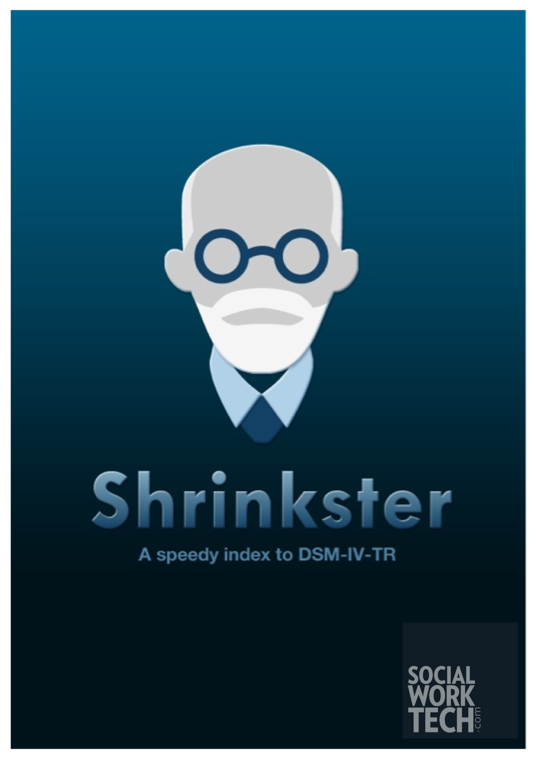This post was rendered irrelevant by the American Psychiatric Association.
An outdated review follows.

It’s almost as if we are not all going to buy DSM-5 when it lands next year. This was such a great app and if you feel the same, here is where to let them know.
My Facebook page (OMG, YOU SHOULD LIKE IT NOW) elicited a suggestion from Paul R., who told me to check out Shrinkster. Bless you, sir!
Holy smokes people… Whether you are a clinical social worker (like me) or not, stop what you’re doing and download Shrinkster for iOS now… It’s free!
Shrinkster works on iPhone, iPod Touch and iPad.
This is an app I use in clinical practice!
What It Does
As stated in the above graphic, Shrinkster is “a speedy index to the DSM-IV-TR”. While I am bummed that our beloved clinical diagnosing tool is scheduled to be out of date sometime next year, it works wonderfully at the present moment.
Shrinkster spells out DSM codes and titles by code, name and title.

This app is easy to use, as a clinician can glide through this app on their iPhone, iPod Touch and iPad (at the iPhone image size) with little fuss to find what they are looking for
In Clinical Practice
In the “Clinical Impression(s)” portion of my case notes, I tend to state what’s working, what’s not, and present areas of clinical focus that may be appropriate for further intervention.
What has enriched this area for me is to be able to quickly add preliminary, provisional, and rule-out diagnoses with DSM codes, which I can refer when formulating a formal treatment plan (after session 3 in my current internship). Shrinkster allows for me to snag these codes, without fuss and knowing that I can further investigate and solidify what my principal diagnoses are for my clients.
I tend to jump to the chapters that I need, as I need. Them, for example, if I want to search for V-Codes, I search “By Chapter” and then “Other Conditions That May Be a focus of Clinical Attention” and voila!

Ethical Considerations

It’s very easy to cookie-cutter every sad client into a “Dysthymic Disorder” or client presenting with multiple issues as “Mood Disorder NOS”. It’s very easy to cookie-cutter every sad client into a “Dysthymic Disorder” or client presenting with multiple issues as “Mood Disorder NOS”.
Within the ethical Principles of the NASW Code of Ethics, the most prevalent value that is spelled out with how we practice is the value of giving dignity and worth to the person that is your client; the ethical principle is that “social workers respect the inherent dignity and worth of the person” (NASW, 2008). Per the NASW “social workers treat each person in a caring and respectful fashion, mindful of individual differences and cultural and ethnic diversity”. in a socially responsible manner consistent with the values, ethical principles, and ethical standards of the profession.
Also to consider is the Competence section, whereas “social workers practice within their areas of competence and develop and enhance their professional expertise”. Section 1.04(a) outlines that “wocial workers should provide services and represent themselves as competent only within the boundaries of their education, training, license, certification, consultation received, supervised experience, or other relevant professional experience”.
In plain English: be mindful that when you use this diagnostic reference tool to assist you, that you use the actual reference tool (i.e. DSM-IV-TR) and clinical supervisor (if appropriate) to guide you in making your clinical judgements.









Diagnosis is based on the self-reported experiences of an individual as well as abnormalities in behavior reported by family members, friends or co-workers, followed by secondary signs observed by a psychiatrist , nurse , social worker , clinical psychologist or other clinician in a clinical assessment. There are lists of criteria for someone to be so diagnosed. These depend on both the presence and duration of certain signs and symptoms. Assessment is usually done on an outpatient basis; admission to an inpatient facility is considered if there is a risk to oneself or others. The most widely used criteria for diagnosing bipolar disorder are from the American Psychiatric Association’s Diagnostic and Statistical Manual of Mental Disorders , the current version being DSM-IV-TR, and the World Health Organization’s International Statistical Classification of Diseases and Related Health Problems , currently the ICD-10. The latter criteria are typically used in Europe and other regions while the DSM criteria are used in the USA and other regions, as well as prevailing in research studies. The DSM-V , to be published in 2013, will likely include further and more accurate sub-typing.